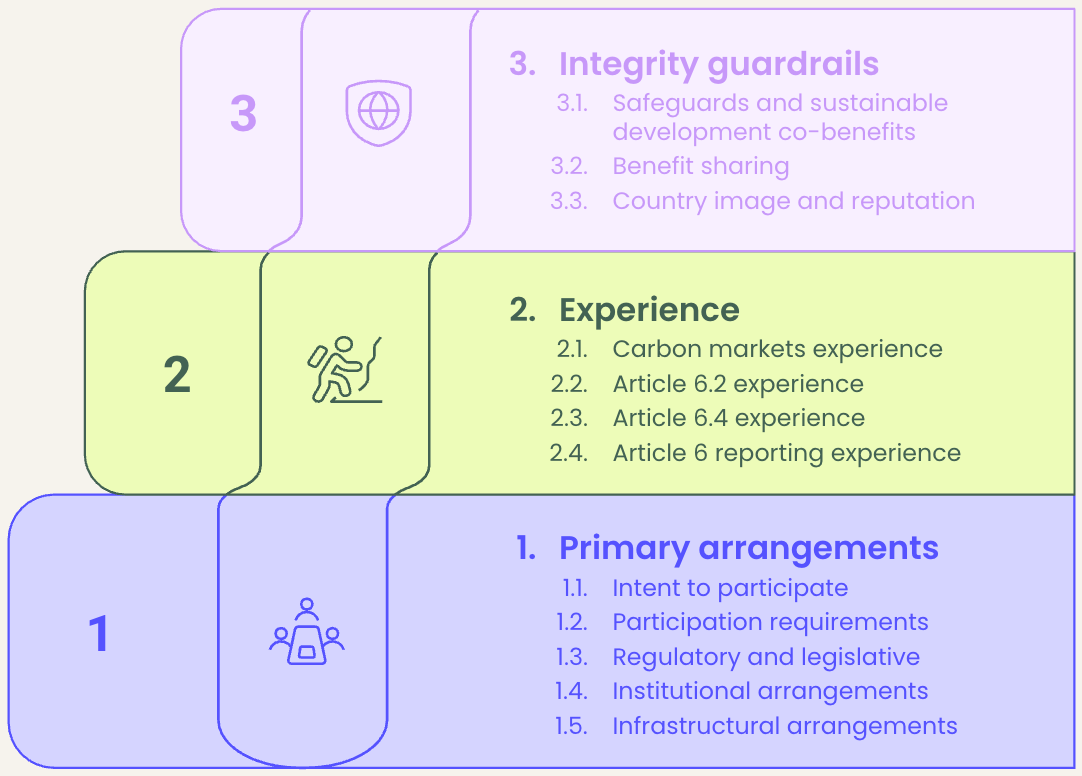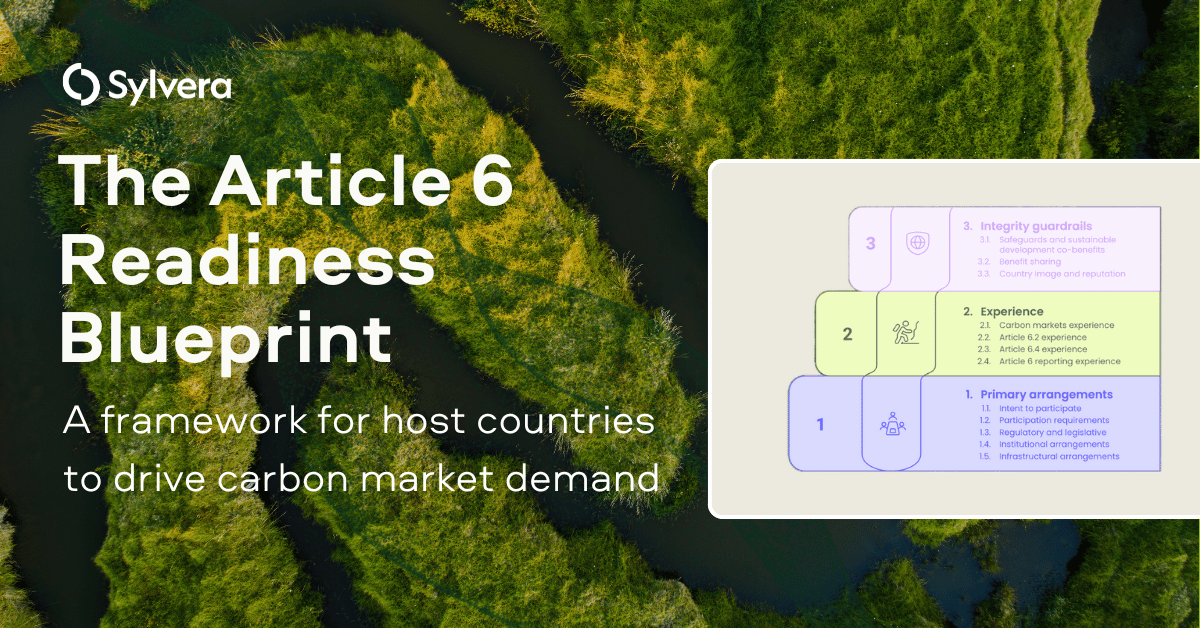“Over the years we’ve invested significantly in our field data team - focusing on producing trusted ratings. While this ensures the accuracy of our Ratings, it doesn’t allow the scale across the thousands of projects that buyers are considering.”
For more information on carbon credit procurement trends, read our "Key Takeaways for 2025" article. We share five, data-backed tips to improve your procurement strategy.

One more thing: Connect to Supply customers also get access to the rest of Sylvera's tools. That means you can easily see project ratings and evaluate an individual project's strengths, procure quality carbon credits, and even monitor project activity (particularly if you’ve invested at the pre-issuance stage.)
Book a free demo of Sylvera to see our platform's procurement and reporting features in action.
The Growing Need for Article 6 Readiness
Following the finalization of Article 6 rules at COP29 in Baku, international carbon markets are entering a critical implementation phase. With 30 bilateral agreements already signed and the Paris Agreement Crediting Mechanism (PACM) set to begin issuing credits, host countries face mounting pressure to demonstrate their readiness to participate effectively in these mechanisms.
However, a significant challenge persists: the pervasive lack of host country readiness. This gap means considerable uncertainty for carbon credit buyers. It limits market participation as well as constraining the supply side of the market.
Many developing countries (which typically host the majority of carbon projects) struggle with the complex requirements introduced by the Paris Agreement, including corresponding adjustments, new reporting obligations, and the need to prevent double-counting of mitigation outcomes.
The stakes are high. Government buyers face increased scrutiny regarding the integrity of their carbon credit procurements, while the private sector must navigate evolving compliance requirements.
Meanwhile, host countries often lack clarity on what key elements are required to attract Article 6 demand, a challenge exacerbated by diverse buyer requirements.
Introducing the Article 6 Readiness Blueprint
To address these challenges, alongside the Climate Action Center of Excellence (CACE), we have developed a comprehensive Article 6 Readiness Blueprint. This is a common framework designed to guide host countries in fostering an ideal environment for attracting demand and investment. The blueprint also serves as a valuable assessment tool for buyers, investors, and capacity-building initiatives.

The blueprint organizes readiness indicators into three interconnected categories:
1. Primary Arrangements: The Foundation
Primary arrangements represent the foundational domestic systems that enable countries to operationalize Article 6. These include:
- Intent to participate: Clear political and strategic signals of interest in Article 6 mechanisms
- Participation requirements: Meeting formal UNFCCC conditions for Article 6 engagement
- Regulatory and legislative arrangements: Legal frameworks governing Article 6 activities
- Institutional arrangements: Clear roles, responsibilities, and coordination structures
- Infrastructural arrangements: Systems for monitoring, tracking, and reporting mitigation outcomes
2. Experience: Practical Implementation
While primary arrangements provide the theoretical structure, genuine readiness is revealed through practical application. Experience indicators include:
- Carbon markets experience: Prior engagement with carbon pricing mechanisms and project development
- Article 6.2 experience: Demonstrated experience with cooperative approaches and bilateral agreements
- Article 6.4 experience: Participation in the Clean Development Mechanism or PACM activities
- Article 6 reporting experience: Track record of meeting transparency and reporting requirements
3. Integrity Guardrails: Ensuring Credibility
Environmental and social integrity has become indispensable in modern carbon markets. Key guardrails include:
- Safeguards and sustainable development co-benefits: Robust systems for managing environmental and social risks
- Benefit sharing: Equitable mechanisms for distributing carbon market proceeds
- Country image and reputation: International standing, governance perceptions, and climate ambition
Download the complete Host Country Article 6 Readiness: Key Aspects to Drive Demand report

How Stakeholders Can Leverage the Blueprint
For Host Countries
The blueprint serves as a comprehensive checklist for governments seeking to enhance their Article 6 readiness. Countries can use it to:
- Conduct self-assessments to identify readiness gaps and prioritize capacity-building efforts
- Develop national Article 6 strategies aligned with international best practices
- Communicate readiness status to potential buyers and partners
- Track progress over time as they build institutional capacity
Leading examples include Ghana's structured approach with conditional NDC measures and positive/negative activity lists, and Thailand's early operationalization through its domestic carbon registry and first ITMO transactions with Switzerland.
For Corporate Buyers and Investors
The framework provides essential due diligence criteria for organizations evaluating potential host countries:
- Risk assessment: Evaluate the likelihood of successful project implementation and ITMO delivery
- Quality assurance: Assess environmental integrity and social safeguards
- Portfolio diversification: Compare readiness levels across multiple jurisdictions
- Long-term planning: Identify emerging markets with improving readiness indicators
For Project Developers
Project developers can use the blueprint to:
- Market selection: Prioritize countries with stronger institutional frameworks
- Partnership strategy: Identify local capacity gaps and collaboration opportunities
- Project design: Align activities with national priorities and regulatory requirements
- Timeline planning: Anticipate regulatory processes and approval timelines
For Capacity-Building Organizations
The blueprint helps align existing initiatives by providing:
- Common assessment criteria for measuring country progress
- Priority identification for targeted technical assistance
- Impact measurement for capacity-building interventions
- Coordination mechanisms among multiple support providers
Real-World Application and Success Stories
Several countries are already demonstrating the blueprint's principles in practice. Cambodia recently submitted its Initial Report to the UNFCCC, clearly outlining its Article 6 framework including designated competent authorities and benefit-sharing mechanisms. Ghana has developed one of the most comprehensive national frameworks, explicitly linking Article 6 activities to conditional NDC measures while establishing clear positive and negative activity lists.
The blueprint also reveals readiness leaders: analysis of 141 ODA-eligible countries identifies Ghana, Kenya, Cambodia, Rwanda, and Zambia as the most advanced based on primary arrangements and experience criteria.
Download the Complete Article 6 Readiness Framework
This blueprint represents the collective expertise of carbon market practitioners and reflects emerging best practices from early Article 6 implementation. The complete framework includes detailed guidance on each readiness component, country case studies, and practical tools for assessment and implementation.
Download the full Host Country Article 6 Readiness: Key Aspects to Drive Demand report to access comprehensive guidance on building Article 6 readiness, detailed country examples, and actionable recommendations for all stakeholders.
















